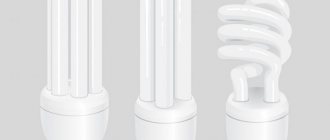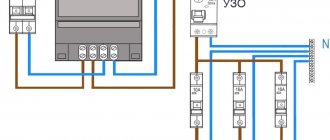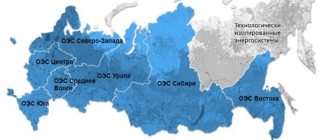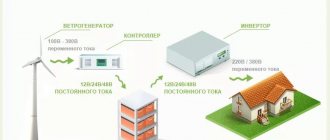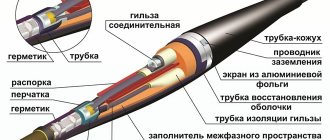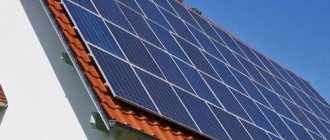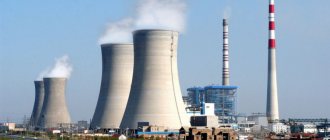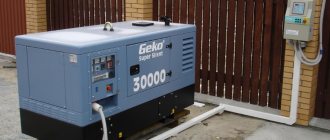Thermal power plants can be equipped with steam and gas turbines, with internal combustion engines. The most common are thermal stations with steam turbines, which in turn are divided into: condensing power plants (CES) - all the steam in which, with the exception of small selections for heating feed water, is used to rotate the turbine and generate electrical energy; cogeneration power plants - combined heat and power plants (CHP) , which are the source of power for consumers of electrical and thermal energy and are located in the area of their consumption.
What is a nuclear power plant?
A nuclear power plant (NPP) is a facility that uses the decay reaction of nuclear fuel to produce energy.
Attempts to use a controlled (that is, controlled, predictable) nuclear reaction to generate electricity were made by Soviet and American scientists simultaneously - in the 40s of the last century. In the 50s, the “peaceful atom” became a reality, and nuclear power plants began to be built in many countries around the world.
The central unit of any nuclear power plant is the nuclear installation in which the reaction occurs. When radioactive substances decay, a huge amount of heat is released. The released thermal energy is used to heat the coolant (usually water), which, in turn, heats the secondary circuit water until it turns into steam. Hot steam rotates turbines, resulting in the generation of electricity.
There is ongoing debate around the world about the feasibility of using nuclear energy to generate electricity. Supporters of nuclear power plants talk about their high productivity, the safety of the latest generation of reactors, and the fact that such power plants do not pollute the environment. Opponents argue that nuclear power plants are potentially extremely dangerous, and their operation and, especially, the disposal of spent fuel are associated with enormous costs.
What is TES?
The most traditional and widespread type of power plants in the world are thermal power plants. Thermal power plants (as this abbreviation stands for) generate electricity by burning hydrocarbon fuels - gas, coal, fuel oil.
The operation scheme of a thermal power plant is as follows: when fuel burns, a large amount of thermal energy is generated, with the help of which water is heated. The water turns into superheated steam, which is supplied to the turbogenerator. Rotating, the turbines set the parts of the electric generator in motion, generating electrical energy.
At some thermal power plants, the heat transfer phase to the coolant (water) is absent. They use gas turbine units, in which the turbine is rotated by gases obtained directly from the combustion of fuel.
A significant advantage of thermal power plants is the availability and relative cheapness of fuel. However, thermal stations also have disadvantages. This is, first of all, an environmental threat to the environment. When fuel is burned, large amounts of harmful substances are released into the atmosphere. To make thermal power plants safer, a number of methods are used, including: fuel enrichment, installation of special filters that trap harmful compounds, the use of flue gas recirculation, etc.
What fuel is used at the station?
Each station uses a separate fuel. It is specially supplied so that the workflow is not disrupted. This point remains one of the problematic ones, as transportation costs arise. What types of equipment does it use?
- Coal;
- Oil shale;
- Peat;
- Fuel oil;
- Natural gas.
Thermal circuits of thermal power plants are built on a certain type of fuel. Moreover, minor changes are made to them to ensure maximum efficiency. If they are not done, the main consumption will be excessive, and therefore the resulting electric current will not be justified.
What is CHP?
The very name of this object resembles the previous one, and in fact, thermal power plants, like thermal power plants, convert the thermal energy of burned fuel. But in addition to electricity, combined heat and power plants (CHP stands for) supply heat to consumers. CHP plants are especially relevant in cold climate zones, where it is necessary to provide residential buildings and industrial buildings with heat. This is why there are so many thermal power plants in Russia, where central heating and water supply to cities are traditionally used.
According to the principle of operation, thermal power plants are classified as condensing power plants, but unlike them, at thermal power plants, part of the generated thermal energy is used to produce electricity, and the other part is used to heat the coolant, which is supplied to the consumer.
CHP is more efficient compared to conventional thermal power plants, since it allows you to use the received energy to the maximum. After all, after the rotation of the electric generator, the steam remains hot, and this energy can be used for heating.
In addition to thermal power plants, there are nuclear thermal power plants, which in the future should play a leading role in the electricity and heat supply of northern cities.
Principle of operation
To begin with, it is worth defining the terms “CHP” and “CHP”. In simple terms, they are sisters. A “clean” thermal power plant - a thermal power plant is designed exclusively for the production of electricity. Its other name is “condensing power plant” - IES.
Combined heat and power plant - CHP - a type of thermal power plant. In addition to generating electricity, it supplies hot water to the central heating system and for domestic needs.
The operation scheme of a thermal power plant is quite simple. Fuel and heated air—an oxidizer—simultaneously enter the furnace. The most common fuel at Russian thermal power plants is crushed coal. The heat from the combustion of coal dust turns the water entering the boiler into steam, which is then supplied under pressure to the steam turbine. A powerful flow of steam causes it to rotate, driving the generator rotor, which converts mechanical energy into electrical energy.
Next, the steam, which has already significantly lost its initial indicators - temperature and pressure - enters the condenser, where after a cold “water shower” it again becomes water. Then the condensate pump pumps it into the regenerative heaters and then into the deaerator. There, the water is freed from gases - oxygen and CO2, which can cause corrosion. After this, the water is reheated from steam and fed back into the boiler.
How do gas powered thermal power plants work?
Compared to coal-fired thermal power plants, thermal power plants with gas turbine units are much more compact and environmentally friendly. Suffice it to say that such a station does not need a steam boiler. A gas turbine unit is essentially the same turbojet aircraft engine, where, unlike it, the jet stream is not emitted into the atmosphere, but rotates the generator rotor. At the same time, emissions of combustion products are minimal.
Types of CHP
Depending on the type of connection between boilers and turbines, combined heat and power plants can be block or non-block (with cross connections). At block thermal power plants, boilers and turbines are connected in pairs (sometimes a double-block diagram is used: two boilers per turbine). Such units, as a rule, have high electrical power: 100-300 MW.
CHPP-1 and CHPP-2 in Severodvinsk CHPP-5 in Novosibirsk
The cross-coupled design allows steam to be transferred from any boiler to any turbine, which increases the flexibility of plant control. However, this requires the installation of large steam pipelines along the main station building. In addition, all boilers and all turbines combined into a circuit must have the same nominal steam parameters (pressure, temperature). If the main equipment of different parameters was installed at the thermal power plant in different years, there should be several cross-linked circuits. To force changes in steam parameters, a reduction-cooling device (RCD) can be used.
According to the type of steam-producing installations, there can be thermal power plants with steam boilers, with combined-cycle plants, with nuclear reactors (nuclear thermal power plant). There may be thermal power plants without steam-producing units - with gas turbine units. Since thermal power plants are often built, expanded and reconstructed over decades (which is associated with a gradual increase in heat loads), many stations have installations of different types. Steam boilers of thermal power plants also differ in the type of fuel: coal, fuel oil, gas.
Based on the type of thermal power output, there are turbines with adjustable cogeneration steam extraction (turbines produced in Russia have the letter “T” in their designation, for example, T-110/120-130), with adjustable production steam extraction (P), with back pressure (“P”). There are usually 1-2 regulated selections of each species; in this case, the number of unregulated extractions used to regenerate heat inside the thermal circuit of the turbine can be any (as a rule, no more than 9, as for the T-250/300-240 turbine). The pressure in production extractions (nominal value is approximately 1-2 MPa) is usually higher than in district heating (approximately 0.05-0.3 MPa). The term “Backpressure” means that the turbine does not have a condenser, and all waste steam is used for the production needs of the enterprises served. Such a turbine cannot operate if there is no backpressure steam consumer. Heating turbines (type “T”) can operate in a similar mode at full heat load: in this case, all the steam goes into the heating exhaust, but the pressure in the condenser is maintained slightly more than nominal (usually no more than 12-17 kPa). For some turbines, it is possible to operate at “deteriorated vacuum” - up to 20 kPa or more.
In addition, steam turbines are produced with a mixed type of extraction: with controlled heating and production extraction (PT), with controlled extraction and back pressure (PR), etc. At CHP plants, turbines of various types can operate simultaneously, depending on the required combination of thermal loads
Blog about energy
Thermal power station (general view drawing)
1 – electric generator; 2 – steam turbine; 3 – control panel; 4 – deaerator; 5 and 6 – bunkers; 7 – separator; 8 – cyclone; 9 – boiler; 10 – heating surface (heat exchanger); 11 – chimney; 12 – crushing room; 13 – reserve fuel warehouse; 14 – carriage; 15 – unloading device; 16 – conveyor; 17 – smoke exhauster; 18 – channel; 19 – ash catcher; 20 – fan; 21 – firebox; 22 – mill; 23 – pumping station; 24 – water source; 25 – circulation pump; 26 – high-pressure regenerative heater; 27 – feed pump; 28 – capacitor; 29 – chemical water treatment plant; 30 – step-up transformer; 31 – low pressure regenerative heater; 32 – condensate pump.
The diagram below shows the composition of the main equipment of a thermal power plant and the interconnection of its systems. Using this diagram, you can trace the general sequence of technological processes occurring at thermal power plants.
Designations on the TPP diagram:
- Fuel economy;
- fuel preparation;
- boiler;
- intermediate superheater;
- high pressure part of a steam turbine (HPC or HPC);
- low pressure part of a steam turbine (LPT or LPC);
- electric generator;
- auxiliary transformer;
- communication transformer;
- main switchgear;
- capacitor;
- condensate pump;
- circulation pump;
- source of water supply (for example, river);
- low pressure heater (LPH);
- water treatment plant (WPU);
- thermal energy consumer;
- return condensate pump;
- deaerator;
- feed pump;
- high pressure heater (HPH);
- slag removal;
- ash dump;
- smoke exhauster (DS);
- chimney;
- blower fan (DV);
- ash catcher
Description of the TPP technological scheme:
Summarizing all of the above, we obtain the composition of a thermal power plant:
- fuel management and fuel preparation system;
- boiler installation: a combination of the boiler itself and auxiliary equipment;
- turbine installation: steam turbine and its auxiliary equipment;
- water treatment and condensate purification installation;
- technical water supply system;
- ash removal system (for thermal power plants operating on solid fuel);
- electrical equipment and electrical equipment control system.
Fuel facilities, depending on the type of fuel used at the station, include a receiving and unloading device, transport mechanisms, fuel storage facilities for solid and liquid fuels, devices for preliminary fuel preparation (coal crushing plants). The fuel oil facility also includes pumps for pumping fuel oil, fuel oil heaters, and filters.
Preparation of solid fuel for combustion consists of grinding and drying it in a dust preparation plant, and preparation of fuel oil consists of heating it, cleaning it from mechanical impurities, and sometimes treating it with special additives. With gas fuel everything is simpler. Preparation of gas fuel comes down mainly to regulating the gas pressure in front of the boiler burners.
The air required for fuel combustion is supplied to the combustion space of the boiler by blower fans (AD). The products of fuel combustion - flue gases - are sucked off by smoke exhausters (DS) and discharged through chimneys into the atmosphere. A set of channels (air ducts and flues) and various elements of equipment through which air and flue gases pass forms the gas-air path of a thermal power plant (heating plant). The smoke exhausters, chimney and blower fans included in it make up a draft installation. In the fuel combustion zone, the non-combustible (mineral) impurities included in its composition undergo chemical and physical transformations and are partially removed from the boiler in the form of slag, and a significant part of them is carried away by flue gases in the form of small ash particles. To protect the atmospheric air from ash emissions, ash collectors are installed in front of smoke exhausters (to prevent their ash wear).
Slag and captured ash are usually removed hydraulically to ash dumps.
When burning fuel oil and gas, ash collectors are not installed.
When fuel is burned, chemically bound energy is converted into thermal energy. As a result, combustion products are formed, which in the heating surfaces of the boiler give off heat to the water and the steam generated from it.
The totality of equipment, its individual elements, and pipelines through which water and steam move form the station’s steam-water path.
In the boiler, the water is heated to saturation temperature, evaporates, and the saturated steam formed from the boiling boiler water is overheated. From the boiler, superheated steam is sent through pipelines to the turbine, where its thermal energy is converted into mechanical energy, transmitted to the turbine shaft. The steam exhausted in the turbine enters the condenser, transfers heat to the cooling water and condenses.
At modern thermal power plants and combined heat and power plants with units with a unit capacity of 200 MW and above, intermediate superheating of steam is used. In this case, the turbine has two parts: a high pressure part and a low pressure part. The steam exhausted in the high-pressure part of the turbine is sent to the intermediate superheater, where additional heat is supplied to it. Next, the steam returns to the turbine (to the low pressure part) and from it enters the condenser. Intermediate superheating of steam increases the efficiency of the turbine unit and increases the reliability of its operation.
The condensate is pumped out of the condenser by a condensation pump and, after passing through low-pressure heaters (LPH), enters the deaerator. Here it is heated by steam to saturation temperature, while oxygen and carbon dioxide are released from it and removed into the atmosphere to prevent equipment corrosion. Deaerated water, called feedwater, is pumped through high-pressure heaters (HPH) into the boiler.
The condensate in the HDPE and deaerator, as well as the feed water in the HDPE, are heated by steam taken from the turbine. This heating method means returning (regenerating) heat to the cycle and is called regenerative heating. Thanks to it, the flow of steam into the condenser is reduced, and therefore the amount of heat transferred to the cooling water, which leads to an increase in the efficiency of the steam turbine plant.
The set of elements that provide cooling water to the condensers is called the technical water supply system. This includes: a water supply source (river, reservoir, cooling tower), circulation pump, inlet and outlet water pipes. In the condenser, approximately 55% of the heat of the steam entering the turbine is transferred to the cooled water; this part of the heat is not used to generate electricity and is wasted uselessly.
These losses are significantly reduced if partially exhausted steam is taken from the turbine and its heat is used for the technological needs of industrial enterprises or for heating water for heating and hot water supply. Thus, the station becomes a combined heat and power plant (CHP), providing combined generation of electrical and thermal energy. At thermal power plants, special turbines with steam extraction are installed - so-called cogeneration turbines. The steam condensate delivered to the heat consumer is returned to the thermal power plant by a return condensate pump.
At thermal power plants, there are internal losses of steam and condensate due to the incomplete tightness of the steam-water path, as well as the unrecoverable consumption of steam and condensate for the technical needs of the station. They constitute approximately 1 - 1.5% of the total steam consumption for turbines.
At thermal power plants there may also be external losses of steam and condensate associated with the supply of heat to industrial consumers. On average they are 35 - 50%. Internal and external losses of steam and condensate are replenished with additional water pre-treated in the water treatment plant.
Thus, boiler feed water is a mixture of turbine condensate and make-up water.
The electrical equipment of the station includes an electric generator, a communication transformer, a main switchgear, and a power supply system for the power plant's own mechanisms through an auxiliary transformer.
The control system collects and processes information about the progress of the technological process and the condition of the equipment, automatic and remote control of mechanisms and regulation of basic processes, automatic protection of equipment.
Source: Poleshchuk I.Z., Tsirelman N.M. Introduction to thermal power engineering: Textbook / Ufa State Aviation Technical University. – Ufa, 2003.
Share with your friends
- Click here to share content on Facebook. (Opens in a new window)
- Click to share on Twitter (Opens in new window)
- Click to share on LinkedIn (Opens in new window)
- Click to share on Telegram (Opens in new window)
- Click to share on WhatsApp (Opens in new window)
- Click to share on Skype (Opens in new window)
- More
- Send this to a friend (Opens in new window)
- Click to print (Opens in new window)
Similar
TPP and CHP: differences
Often people confuse these two concepts. CHP, in fact, as we found out, is one of the types of thermal power plants. Such a station differs from other types of thermal power plants primarily in that part of the thermal energy it generates goes to boilers installed in the premises to heat them or to produce hot water.
Also, people often confuse the names of hydroelectric power stations and state district power stations. This is primarily due to the similarity of abbreviations. However, a hydroelectric power station is fundamentally different from a state district power station. Both of these types of stations are built on rivers. However, at a hydroelectric power station, unlike state regional power plants, it is not steam that is used as an energy source, but the water flow itself.
What are the requirements for thermal power plants?
A thermal power plant is a thermal power station where electricity is generated and consumed simultaneously. Therefore, such a complex must fully comply with a number of economic and technological requirements. This will ensure uninterrupted and reliable supply of electricity to consumers. So:
- thermal power plant premises must have good lighting, ventilation and aeration;
- the air inside and around the plant must be protected from contamination by solid particles, nitrogen, sulfur oxide, etc.;
- water supplies should be carefully protected from the ingress of wastewater;
- Water treatment systems at stations should be waste-free.
Advantages of TPP
A thermal power plant is thus a station whose main type of equipment is turbines and generators. The advantages of such complexes include primarily:
- low cost of construction compared to most other types of power plants;
- cheapness of the fuel used;
- low cost of electricity generation.
Also, a big advantage of such stations is that they can be built in any desired location, regardless of the availability of fuel. Coal, fuel oil, etc. can be transported to the station by road or rail.
Another advantage of thermal power plants is that they occupy a very small area compared to other types of stations.
Definition
A thermal power plant is a power plant that uses any fossil fuel as an energy source. The latter can be used, for example, oil, gas, coal. Currently, thermal complexes are the most common type of power plants in the world. The popularity of thermal power plants is explained primarily by the availability of fossil fuels. Oil, gas and coal are available in many parts of the planet.
TPP is (the abbreviation itself looks like “thermal power plant”), among other things, a complex with a fairly high efficiency. Depending on the type of turbines used, this figure at stations of this type can be 30 - 70%.
The main thing is electricity
The designation “GRES” is a relic of the Soviet industrial megaproject, at the initial stage of which, within the framework of the GOELRO plan, the task of eliminating the shortage, first of all, of electrical energy was solved. It simply stands for “state regional power station.” In the USSR, districts were called territorial associations (industry with population) in which a unified energy supply could be organized. And at key geographical points, usually near large deposits of raw materials that could be used as fuel, state district power plants were installed. However, gas can be supplied to such stations through pipelines, and coal, fuel oil and other types of fuel can be delivered by rail. And to the Berezovskaya State District Power Plant in Sharypovo, Krasnoyarsk, coal generally arrives along a 14-kilometer conveyor belt.
In the modern understanding, a state district power plant is a condensing power plant (CPS), which is very powerful compared to a thermal power plant. After all, the main task of such a station is to generate electricity, and in the basic mode (that is, evenly throughout the day, month or year). Therefore, state district power plants, as a rule, are located far from large cities - thanks to power lines, such generation facilities operate for the entire energy system. And even for export - like, for example, the Gusinoozerskaya State District Power Plant in Buryatia, which since its launch in 1976 has provided the lion's share of supplies to Mongolia. And fulfilling the role of a “hot reserve” for this country.
It is interesting that not all stations with the abbreviation “GRES” in their names are condensing ones; some of them have been operating as thermal power plants for a long time. For example, Kemerovo State District Power Plant of Siberian Generating Company. Coal consumption for electricity and heat at the station today is in the proportion of 50 to 50,” explains Alexey Kutyrev, head of the TPP operation department of the Kuzbass branch of SGK, to Oxygen.LIFE.
At the same time, at other state district power plants that are part of the SGC - for example, at Tom-Usinskaya (1345.4 MW) and Belovskaya (1260 MW) in Kuzbass, as well as at Nazarovskaya (1308 MW) in the Krasnoyarsk Territory - 97% of the coal burned is to generate electricity. And only 3% goes to heat generation. And the picture is the same, with rare exceptions - at almost any other state district power station.
Alexey Kutyrev Head of the Operation Department of Thermal Power Plants of the Kuzbass Branch
“For thermal power plants, electricity, unlike state district power plants, is a by-product; such stations in the USSR and Russia work primarily to heat the coolant - and generate heat, which then goes to residential buildings or industrial enterprises in the form of steam. And how much electricity is produced in the end is not so important. It is important to provide the necessary gigacalories so that consumers, mainly the population, feel comfortable.”
The largest thermal power plant in Russia and the third thermal station in the world is Surgutskaya SDPP-2 (part of Unipro) - its capacity is 5657.1 MW (only two hydroelectric power stations in our country, Sayano-Shushenskaya and Krasnoyarsk, are more powerful). With a fairly decent capacity factor of more than 64.5%, this station generated almost 32 billion kWh of electrical energy in 2022. This power plant runs on associated oil and natural gas. The largest power plant in the country operating on solid fuel (coal) is Reftinskaya - it is located 100 km from Yekaterinburg. 3.8 GW of electrical power allows generating volumes that cover 40% of the needs of the entire Sverdlovsk region. Ekibastuz coal is used as the main fuel at the station.
Kemerovo State District Power Plant has long been repurposed into a classic combined heat and power plant; it retains only its historical name - State District Power Plant.
Examples of stations
So, any thermal power plant or power plant can be considered quite productive and to some extent even a universal object. We present examples of such complexes in the list below.
- Belgorod Thermal Power Plant. The power of this station is 60 MW. Its turbines run on natural gas.
- Michurinskaya CHPP (60 MW). This facility is also located in the Belgorod region and runs on natural gas.
- Cherepovets GRES. The complex is located in the Volgograd region and can operate on both gas and coal. The power of this station is as much as 1051 MW.
- Lipetsk CHPP-2 (515 MW). Powered by natural gas.
- CHPP-26 "Mosenergo" (1800 MW).
- Cherepetskaya GRES (1735 MW). The fuel source for the turbines of this complex is coal.
Warmth is a priority
Combined heat and power plants (CHP) are another type of thermal power plant, but this is not a condensing plant, but a heating plant. CHP plants mainly produce heat - in the form of process steam and hot water (including for hot water supply and heating of residential and industrial facilities). Therefore, CHP plants are a key element in centralized heat supply systems in cities, in terms of the level of penetration of which Russia is one of the world leaders. Medium and small thermal power plants are also indispensable satellites of large industrial enterprises. The key feature of CHP is cogeneration: simultaneous production of heat and electricity. This is both more efficient and more profitable than generating, for example, only electricity (as in state district power plants) or only heat (as in boiler houses). That is why the USSR at one time relied on the widespread development of district heating.
The fundamental difference between thermal power plants and state district power plants is that all these are boiler-turbine and steam-turbine power plants - different types of turbines. Cogeneration turbines of the “T” type are installed at thermal power plants, the difference between which and the condensing turbines of the “K” type (which operate at state district power plants) is the presence of controlled steam extraction. Subsequently, it is sent, for example, to network water heaters, from where it goes to apartment radiators or hot water taps. Historically, the most widespread in our country are the T-100 turbines, the so-called “hundreds”. But back-pressure turbines of the “P” type also work at thermal power plants, which produce process steam (they do not have a condenser and the steam, after generating electricity in the flow part, goes directly to the industrial consumer). There are also turbines of the “PT” type, which can work for both industry and district heating.
In “K” type turbines, the process of steam expansion in the flow section ends with its condensation (which makes it possible to obtain greater power in one installation - up to 1.6 GW or more).
Alexey Kutyrev Head of the Operation Department of Thermal Power Plants of the Kuzbass Branch
“For thermal power plants, electricity, unlike state district power plants, is a by-product; such stations in the USSR and Russia work primarily to heat the coolant - and generate heat, which then goes to residential buildings or industrial enterprises in the form of steam. And how much electricity is produced in the end is not so important. It is important to provide the necessary gigacalories so that consumers, mainly the population, feel comfortable.”
During the heating season, CHP plants operate according to the so-called “thermal schedule” - they maintain the temperature of the network water in the main depending on the outside air temperature. In this mode, CHP plants can also carry the base load of electricity, demonstrating, by the way, very high installed capacity utilization factors (IUR). According to the electrical schedule, CHP plants usually operate in the warm months of the year, when the heating output from the turbines is turned off. State district power plants operate exclusively according to an electrical schedule.
It is not difficult to guess that thermal power plants in Russia are much larger than state regional power plants - and all of them, as a rule, differ greatly in power. There are also a great variety of options for their work. Some thermal power plants, for example, operate as state district power plants - such as, for example, CHPP-10. Others operate in close conjunction with industrial enterprises - and therefore do not reduce their capacity even in the summer. For example, Kazan CHPP-3 TGK-16 supplies steam to the chemical industry giant Kazanorgsintez (both companies are part of the TAIF Group). And the Novo-Kemerovskaya CHPP of the SGK generates steam for the needs of KAO Azot. Some stations provide heat and hot water primarily to the population - for example, all four thermal power plants in Novosibirsk have practically stopped producing process steam since the 1990s.
It happens that combined heat and power plants do not produce electrical energy at all - although these are now in the minority. This is due to the fact that, unlike gigacalories, the cost of which is strictly regulated by the state, kilowatts in Russia are a market product. Under these conditions, even those thermal power plants that had not previously worked on the wholesale electricity and capacity market tried to enter it. In the structure of the SGC, for example, Krasnoyarsk CHPP-3 went through this path, which until March 2012 produced only thermal energy. But on March 1 of that year, the first coal-fired power unit in Russia with a capacity of 208 MW, built under the CSA, was put into operation. Since then, this station has generally become an exemplary one in the SGC in terms of energy efficiency and environmental friendliness.
Until March 2012, Krasnoyarsk CHPP-3 produced only thermal energy. And now it is exemplary in the SGC in terms of energy efficiency and environmental friendliness.
The largest thermal power plants in Russia operate on gas and are under the wing of Mosenergo. The most powerful can probably be considered CHPP-26, located in the Biryulyovo Zapadnoe district of Moscow - at least in terms of electrical power of 1841 MW, it is ahead of all other CHPPs in the country. This power plant provides centralized heat supply to industrial enterprises, public and residential buildings with a population of more than 2 million people in the Chertanovo, Yasenevo, Biryulevo and Maryino districts. The thermal power of this thermal power plant, although high (4214 Gcal/hour), is not a record. CHPP-21 of the same Mosenergo has a higher heat capacity - 4918 Gcal/hour, although in terms of electricity it is slightly inferior to its “colleague” (1.76 GW).
In what cases is this equipment chosen?
When the costs of transmitting or producing electricity are high and the budget of an organization or individual cannot bear them. If centralized systems for supplying heat and electricity cannot cope with additionally constructed or commissioned areas.
When the amount of electricity is simply not enough for the smooth operation of modern equipment and devices. Or it is of low quality. We also must not forget about the environmental component of the equipment, which allows the release of harmful substances into the atmosphere.
Mathematical models and methods used in thermal power plant control problems
As is known, the technological process on a vehicle consists of a step-by-step transformation of various types of energy. The technological process has a peculiarity - the final product - electricity - cannot be stored. An indirect indicator of the correspondence between the steam output of the boiler and the power of the turbine is the pressure of superheated steam.
Modern thermal power plants are divided into two types:
- Cross-linked. The main unit for steam and water are interconnected
- With block layout. With this type, the main equipment is described by a separate technological process within each power unit.
To describe technological processes and formulate control criteria, mathematical models
. They are depicted in the form of equations.
A typical power unit is usually chosen as a control object characterizing the technological process at a thermal power plant as a whole. The technological process occurring in such a block can be represented as two sequential processes: in a steam boiler and a turbogenerator.
Versatility and cost-effectiveness
Power plants can run on wood or coal, gas, or diesel fuel. Typically, diesel fuel is rarely used due to its high cost and harmful emissions. There are several modifications of these settings and they are distinguished:
- Steam powered turbines.
- Gas turbines.
- Gas piston generators.
The choice of thermal power plant depends on the required power for the consumer. Gas piston engines are considered the most popular, however, their power is only 80 mW .
